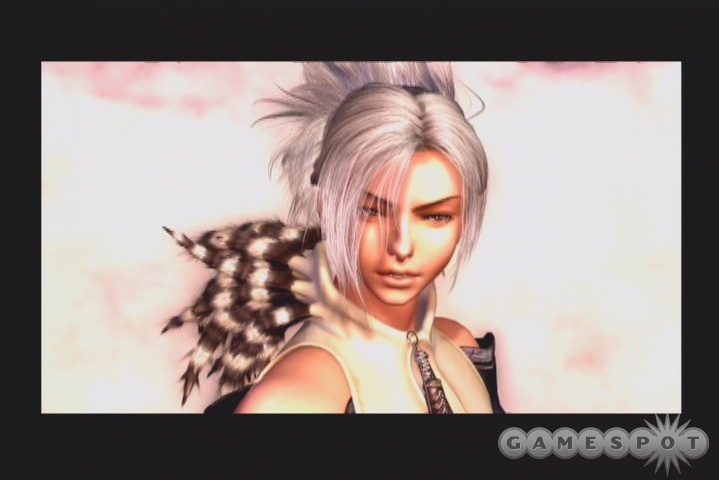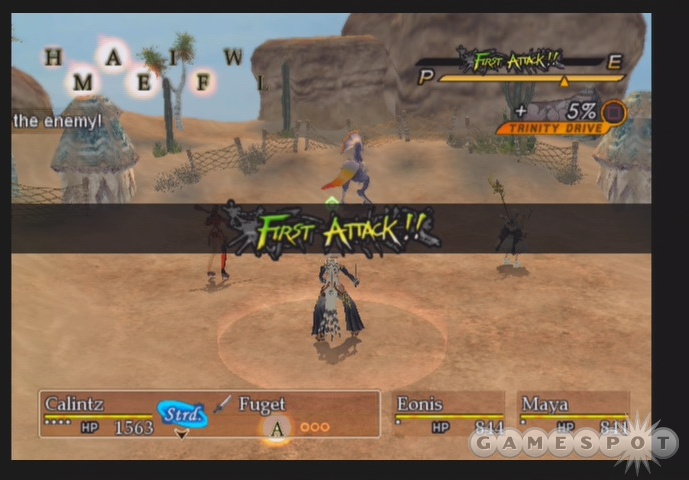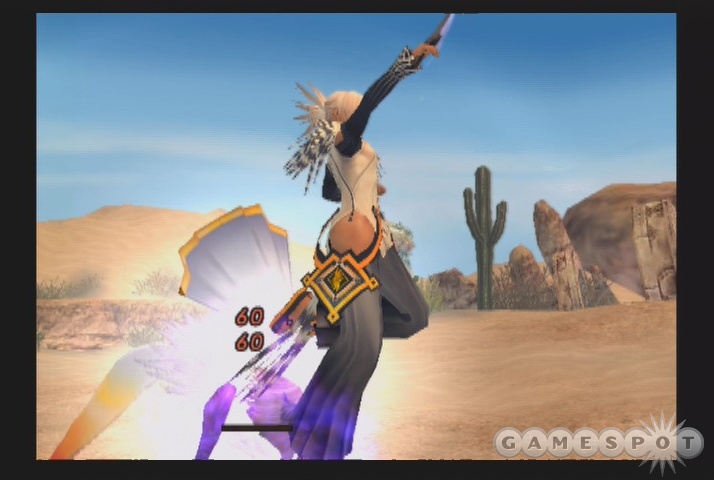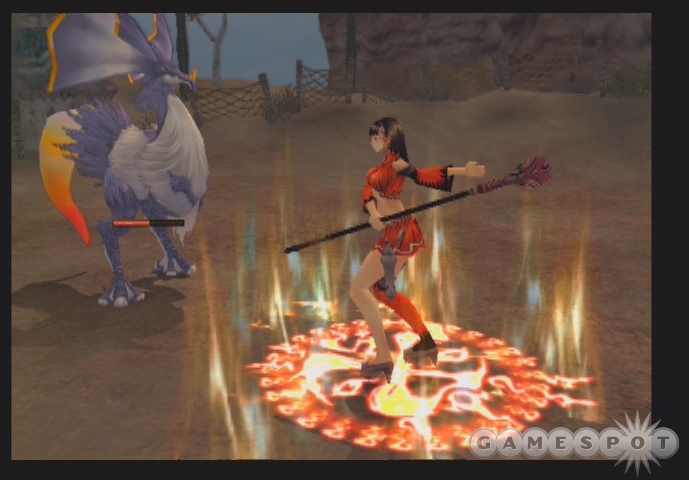The Final Fantasy series has been on somewhat of a break for the past four years, giving other companies plenty of opportunity to try to grab a piece of the console role-playing market while the juggernaut franchise from Square Enix lies dormant. Series like Shadow Hearts and Digital Devil Saga have all put their own unique spins on the genre while simultaneously delivering the basic story-driven, stat-building gameplay that role-playing veterans crave. Magna Carta: Tears of Blood attempts to do the same, and for the most part it succeeds, thanks to a compelling story, interesting characters, and a unique battle system.

Magna Carta: Tears of Blood takes place in the world of Efferia, where two races, the humans and the Yason, are locked in a bitter struggle for control of the land. The humans and the Yason are pretty much the same. The Yason are a bit more in tune with nature, and they have strange-looking ears, but functionally there isn't much of a difference between the two races. You control a hotheaded transvestite named Calintz, who is the captain of a group of mercenaries known as the Tears of Blood. The game picks up the story just as the humans launch a massive attack on the Yason in an attempt to end the war once and for all. The Tears of Blood join the effort, but the attack is foiled by the mysterious Queen Amilia of the Yason. As the Tears of Blood retreat, Calintz meets a strange amnesic girl named Reith, who has mystical healing powers beyond anything anyone has seen.
The two strike up an awkward and unrequited romance that carries the story through the adventure of trying to figure out who Reith is, where her powers came from, and how she can help bring peace to the world of Efferia. The story is full of mysticism and unexplained coincidences, but there are also plenty of political undertones as well. The cast of characters is bizarre, but interesting and well developed. It starts out a bit slow, but there's plenty of story here to hold your interest throughout the game. The story doesn't pull any punches, either, taking on heavier subjects like death and betrayal, while throwing in plenty of interesting plot twists to keep you guessing.
The biggest problem with the story is that the progression is so linear that it feels restrictive. There's no opportunity to stray off the path, because if you do a character will stop you and tell you to go another way. There are a few side quests you can pick up on, but for the most part you'll just be walking a narrow path from point A to point B. It feels like you're just going through the motions as the game dictates, rather than embarking on an epic quest of your own volition.

Most of the quests are pretty basic. There are quite a few missions where you have to travel to one town to gather information, only to get there and find out that the information you really need is in yet another town. As you travel from place to place you'll run into a variety of monsters that you can fight to earn experience and level up your characters. You can see the monsters on the map, and if you touch one you'll be pulled into a battle. The monsters are all laid out in specific areas, though, so the battles aren't actually random. This makes it a bit more difficult to power level your characters, although you really don't need to do that anyway. As long as you clear each area you visit, you'll level up at a pace that basically guarantees that you won't have any trouble with any of the enemies in the game.
The battle system in Magna Carta uses a mechanic similar to the judgment wheel in Shadow Hearts: Covenant. You can bring a party of three characters into battle, but you only ever control a single character. To attack, you simply have to run up to an enemy and the trinity circle will appear. This is basically just a little diagram with three button icons. By hitting the right button at the correct time, you'll get a "good" or a "great" success. If you do that with all three buttons, you'll be able to successfully attack. If you miss any of the three button presses, you'll fail the attack and lose your turn. If you get "great" on all three button presses, you'll get a boost to your trinity drive gauge. The trinity drive gauge is like an overdrive gauge that you can activate to boost your attack. By scoring all "great" hits, you can also perceive new moves. Each character can learn multiple fighting styles, and each fighting style has four different moves, which are activated with different combinations of buttons on the trinity circle. Only the X and circle buttons are used, though, so the combos never get too complex. In fact, you can get the timing down pretty easily, and after the first few minutes of the game you won't really have to worry about missing any attacks.
Initiative in battle is based on a leadership gauge, which is displayed in the top-right corner of the screen. The gauge constantly fills up as long as you're standing still, and once it reaches a certain point, you can attack. This action point varies depending on how many enemies you're fighting, and depending on how much other characters in your party trust you. If you're controlling a character that doesn't trust you at all, you'll need a lot of leadership in order for that character to act. The leadership mechanic is important to keep your eye on, because it can mean the difference between victory and defeat. If you play it right, you can often get two or three attacks for every one the enemy gets. That sword cuts both ways, though, so it's important to gain the trust of your allies. You can do that by giving them gifts or talking to them in a sort of minigame that essentially plays like a Japanese dating sim.

Every attack requires a specific type of chi. There are eight different types of elemental chi, and you can use talismans to replenish or alter chi as you see fit. Every battlefield you fight in has specific elemental properties that you have to pay attention to, because if the area you're in doesn't have the right kind of chi, you won't be able to attack. You can master multiple fighting styles with different chi associations, so if one type of chi runs out you can switch styles and keep fighting. It's also good to have a lot of variety within your party, so if one character is crippled by a lack of chi, you can switch to another character and finish the battle. The biggest problem with the chi system is that the icons used to represent the various elements aren't very intuitive. It takes awhile to memorize what each letter stands for, and it seems like it would be much easier to have a picture or a color to denote the various types of chi, rather than a plain boldface letter.
The battles are interesting overall, but as with most of these kinds of role-playing games, the battles can get repetitive after awhile. It's also strange to bring three characters into battle only to have two of those characters stand there doing absolutely nothing. The battle system is easy to exploit, as well. For example, you can just have a tank character stand in front of the two other characters, and since the enemies always attack the closest character, they'll just go after your tank while you use one of your other characters to deal damage. By doing this, you'll pretty much never have to worry about losing a battle.
Whether you're in battle or just walking around town, you'll be treated to plenty of nice sights in Magna Carta. Actually, at first glance you could easily mistake this game for a Final Fantasy title. The world of Efferia has the same sort of exotic fantasy theme that you've seen in countless other role-playing games, but it looks nice even if it isn't entirely original. The lush vegetation and primitive structures all share the same cohesive look, although there's a bit of a disconnect between different areas, since the transitions take place on a map rather than in the actual living, breathing world. The characters are all extremely detailed and their battle animations look great. Some of the characters are a bit garish to really be believable, and some are just plain strange. If you like your men to look like women and your women to look like porn stars, then you'll love the cast of characters here. The biggest problem with the visuals is that they're often obscured due to some awkward, fixed camera angles. There are times in battle where you can't even see your own characters. What's even worse is when you're running around between battles and you can't see the enemies in your path.

Magna Carta unfortunately doesn't sound as good as it looks. The voice-overs are absolutely terrible. The voices are all delivered without any inflection whatsoever, which makes the characters seem wooden and lifeless. Chalintz sounds like Matthew Broderick, which doesn't exactly give him a forceful presence on the battlefield. The music is all quite well done, with plenty of orchestral themes and a choral chant thrown in for good measure. The main title song is horrendous, though. It sounds like a B-side from one of Celine Dion's backup singer's failed attempts at a solo career. The battle noises and other sound effects are entirely unremarkable and you won't ever pay attention to them.
Magna Carta: Tears of Blood is a decent game for people who are craving a simple but satisfying role-playing experience. You can spend 40 or more hours getting through it, but once you finish it there isn't much reason to ever come back. The story is the strongest part of the game, and it would be interesting to see the world of Efferia fleshed out just to give it a little more depth. If Dragon Quest VIII is a bit too straightforward for you, and if you're looking for something to hold you over until Final Fantasy XII, you'd do well to check out Magna Carta.



